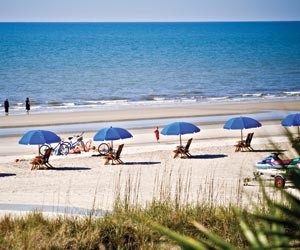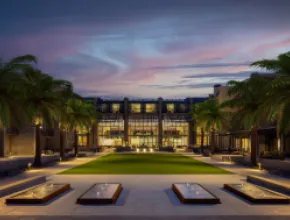Your take-home experience from Hilton Head Island may not be the golf or tennis you play, but rather an encounter with its culture, history and natural beauty.
Sure, take along your clubs and racket, because everyone knows there’s an array of championship greens, courts and elegant clubs that have put the island on professional sporting maps, but don’t miss what makes this destination more diverse than many visitors expect. At the very least, stop to notice the moss-draped oaks all around; they suggest an era apart, before modern distractions.
Enlightened developers in the 1950s were ahead of their time as they created this first environmentally sensitive resort area, one that continues to hold that standard. You won’t see any neon signs, billboards or buildings over five stories high. Posh homes in gated housing developments lurk in these Lowcountry grasses and lush landscaping. Roads meander along canals and golf courses. Five decades of careful preservation development have left miles of beaches, marshes, lagoons and pine forests in place. It’s easy to see stars at night.
This is not to say meetings groups won’t find what they need. Besides major resort properties like Westin Hilton Head Island Resort & Spa, with 28,999 square feet of meeting space and 412 guest rooms; Hilton Oceanfront Resort Hilton Head Island, with 25,000 square feet of meeting space and 323 studio suite rooms; and Sea Pines Resort and the Inn at Harbour Town, with 15,000 square feet of conference space, a 60-room boutique inn and private home and villa properties, there is a smorgasbord of restaurant options and, of course, all those world-class golf courses and tennis courts.
"People don’t expect Hilton Head to be what it is," says Charlie Clark, vice president of communications for the Hilton Head CVB. "We are not all about golf. History from the Civil War and culture are everywhere, and of particular interest is the Gullah culture. Our outdoor activities—those people can enjoy within our resorts and into nature—just don’t stop."
Hilton Head Island is a semitropical barrier island on the Intracoastal Waterway off the South Carolina coast. Charleston lies about 90 miles south, Savannah 40 miles north. At 12 miles long and five miles wide, Hilton Head is the largest barrier island between Long Island and the Bahamas.
Turtle watches, crabbing expeditions, boat cruises and horseback riding are ways to get out into the natural world. Coastal Discovery Museum at Honey Horn offers live alligator demonstrations, dolphin tours and exhibits about local wildlife, and the island is a loggerhead sea turtle nesting ground. Here, visitors can join locals in turtle watches and participate in activities that protect nesting areas along beaches. Hilton Head outfitters offer paddling tours so visitors can discover the island’s environment among salt marshes and tidal creeks. It’s during these excursions one is likely to spot white ibis, herons, egrets and maybe bald eagles and deer. Cycling and hiking along the island’s gravel trails are also popular.
The Gullah culture—and the art that reflects it—is another top island attraction. The original Gullah people originated as African slaves who were taken from West Africa to work the South’s cotton plantations. With that culture came a combination of language, folktales and superstition, a mix that has shaped generations of island and Lowcountry families.
Groups may experience Gullah culture in several ways. Artists who continue to make the famed sweet grass baskets do on-site demonstrations for groups, and there are seasonal festivals and other events on Hilton Head that celebrate the Gullah. Nearby Daufuskie Island, which is accessible by boat or plane, was once a vibrant Gullah community, and signs of the past remain, such as a historic church, schoolhouse and a praise house—a place where people gathered for spiritual and cultural expression.
So while visitors may typically keep their eye on the golf ball in Hilton Head, it does indeed pay to look around.






